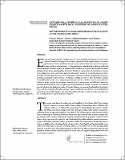Por favor, use este identificador para citar o enlazar a este item:
http://hdl.handle.net/10261/115862COMPARTIR / EXPORTAR:
 SHARE SHARE
 CORE
BASE CORE
BASE
|
|
| Visualizar otros formatos: MARC | Dublin Core | RDF | ORE | MODS | METS | DIDL | DATACITE | |

| Título: | Software to identify climate change trends at the local level: A study case in Yucatán, México |
Autor: | Bautista, F.; Bautista-Hernández, Dorian A.; Álvarez, Oscar; Anaya Romero, María CSIC ORCID; Rosa, Diego de la CSIC | Palabras clave: | Temperatures Climatic indexes Evapotranspiration Humidity index |
Fecha de publicación: | ene-2013 | Editor: | Universidad Autónoma Chapingo | Citación: | Revista Chapingo, Serie Ciencias Forestales y del Ambiente 19: 81- 90 (2013) | Resumen: | [EN]: The present work shows the architecture and capabilities of the software titled >Data Analysis System for monitoring regional and local climate change with agroclimatic indexes> (Moclic). The software works as: a) a database; b) a processing tool of agroclimatic data; and c) a tool for identifying local climate change trends. The advantages of using Moclic include its capacity for evaluating climate change within a graphical user interface. The software requires input data from weather stations containing the following information: station name, key number, locality and state, monthly average, minimum and maximum temperatures, monthly precipitation and the geographic coordinates of the station. Moclic can process the input data and calculate derived variables related to potential evapotranspiration and monthly and annual indexes for humidity, aridity, the growing season, precipitation concentration, erodibility, and soil leaching. Moclic software works in both English and Spanish. Finally, a case study of the Abalá station in the state of Yucatán, México is presented in order to show the applicability of Moclic at the local level. The results from the case study show the high accuracy of the Moclic for the prediction of climate change trends throughout the last 40 years, and suggest its high potential to be used in new climate scenarios. [ES]: El presente trabajo muestra la arquitectura y las funcionalidades del software conocido como “Sistema de análisis de datos para el monitoreo regional y local del cambio climático con índices agroclimáticos” Moclic. El software funciona como: a) base de datos, b) herramienta de procesamiento de datos agroclimáticos, y c) herramienta para identificar las tendencias locales del cambio climático. Entre las ventajas de utilizar Moclic se incluye su capacidad para evaluar el cambio climático dentro de una interfaz gráfica de usuario. El software requiere datos de entrada de la estación meteorológica, los cuales contienen la siguiente información: nombre de la estación; número de clave; localidad y estado; promedios mensuales, temperaturas mínimas y máximas, precipitación mensual y coordenadas geográficas de la estación. Con Moclic se pueden procesar los datos de entrada y calcular las variables relacionadas con la evapotranspiración potencial y los índices (anuales y mensuales) de humedad, aridez, estación de crecimiento, concentración de precipitación, erodabilidad y lixiviación del suelo. Moclic funciona tanto en inglés como en español. En este trabajo se presenta un estudio de caso de la Estación de Abalá en el estado de Yucatán, México, para mostrar la aplicabilidad de Moclic a nivel local. Los resultados obtenidos muestran la gran exactitud de este software, para la predicción de las tendencias de cambio climático a lo largo de los últimos 40 años, y sugieren su alto potencial, para que sea utilizado en los nuevos escenarios climáticos. |
Versión del editor: | http://dx.doi.org/10.5154/r.rchscfa.2011.09.073 | URI: | http://hdl.handle.net/10261/115862 | DOI: | 10.5154/r.rchscfa.2011.09.073 | Identificadores: | doi: 10.5154/r.rchscfa.2011.09.073 issn: 2007-3828 |
| Aparece en las colecciones: | (IRNAS) Artículos |
Ficheros en este ítem:
| Fichero | Descripción | Tamaño | Formato | |
|---|---|---|---|---|
| Software_identificar_tendencias_cambio_climatico.pdf | 964,02 kB | Adobe PDF |  Visualizar/Abrir |
CORE Recommender
SCOPUSTM
Citations
5
checked on 12-abr-2024
WEB OF SCIENCETM
Citations
10
checked on 20-feb-2024
Page view(s)
400
checked on 17-abr-2024
Download(s)
318
checked on 17-abr-2024
Google ScholarTM
Check
Altmetric
Altmetric
Este item está licenciado bajo una Licencia Creative Commons

